University Financial Accounting Report: OZ Minerals Analysis
VerifiedAdded on 2022/11/26
|9
|2880
|450
Report
AI Summary
This report provides an analysis of the financial accounting practices of OZ Minerals, an ASX-listed mining company. The report begins by outlining key accounting concepts such as money measurement, cost, full disclosure, going concern, accounting period, and business entity concepts, and the...
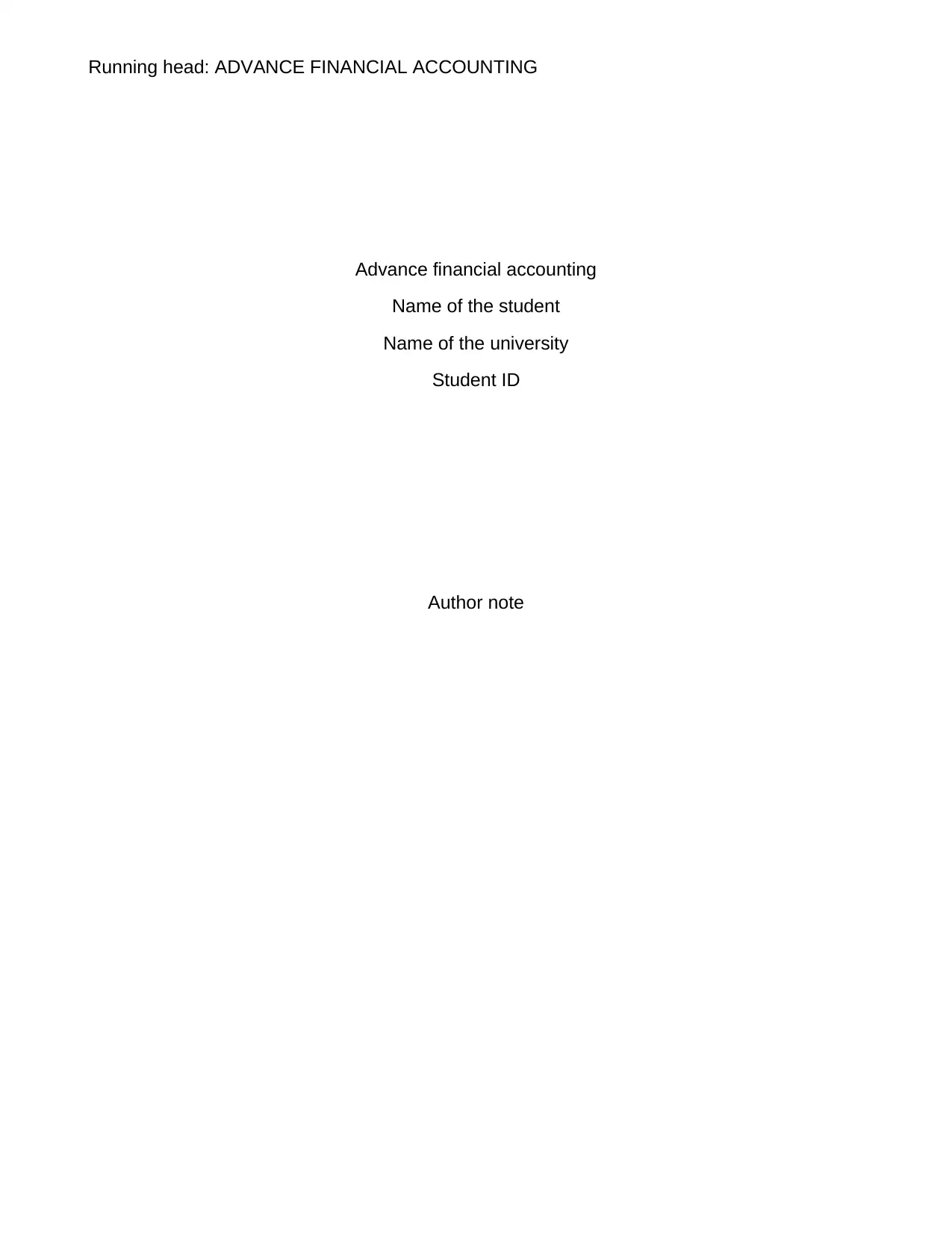
Running head: ADVANCE FINANCIAL ACCOUNTING
Advance financial accounting
Name of the student
Name of the university
Student ID
Author note
Advance financial accounting
Name of the student
Name of the university
Student ID
Author note
Paraphrase This Document
Need a fresh take? Get an instant paraphrase of this document with our AI Paraphraser
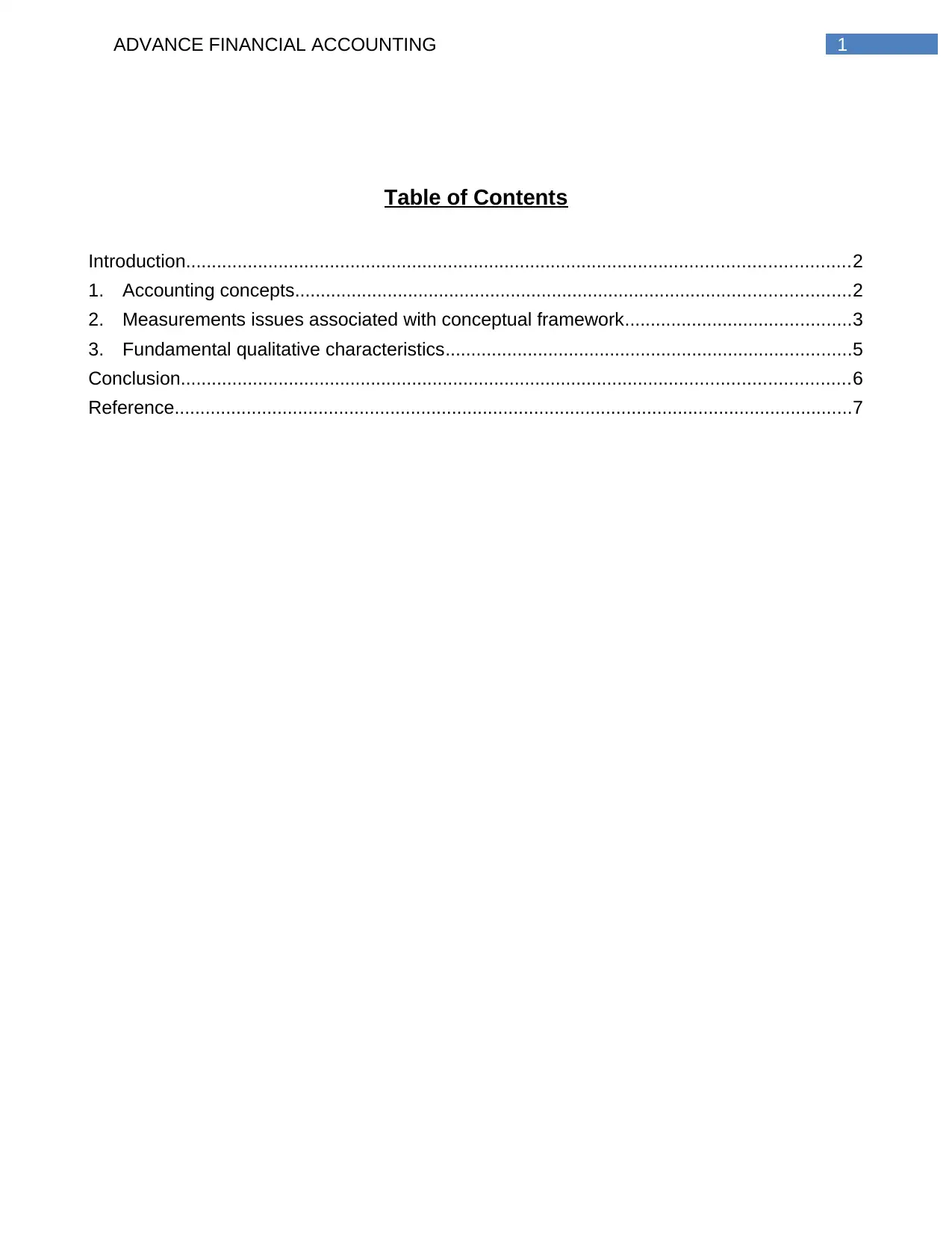
1ADVANCE FINANCIAL ACCOUNTING
Table of Contents
Introduction.................................................................................................................................2
1. Accounting concepts............................................................................................................2
2. Measurements issues associated with conceptual framework............................................3
3. Fundamental qualitative characteristics...............................................................................5
Conclusion..................................................................................................................................6
Reference....................................................................................................................................7
Table of Contents
Introduction.................................................................................................................................2
1. Accounting concepts............................................................................................................2
2. Measurements issues associated with conceptual framework............................................3
3. Fundamental qualitative characteristics...............................................................................5
Conclusion..................................................................................................................................6
Reference....................................................................................................................................7
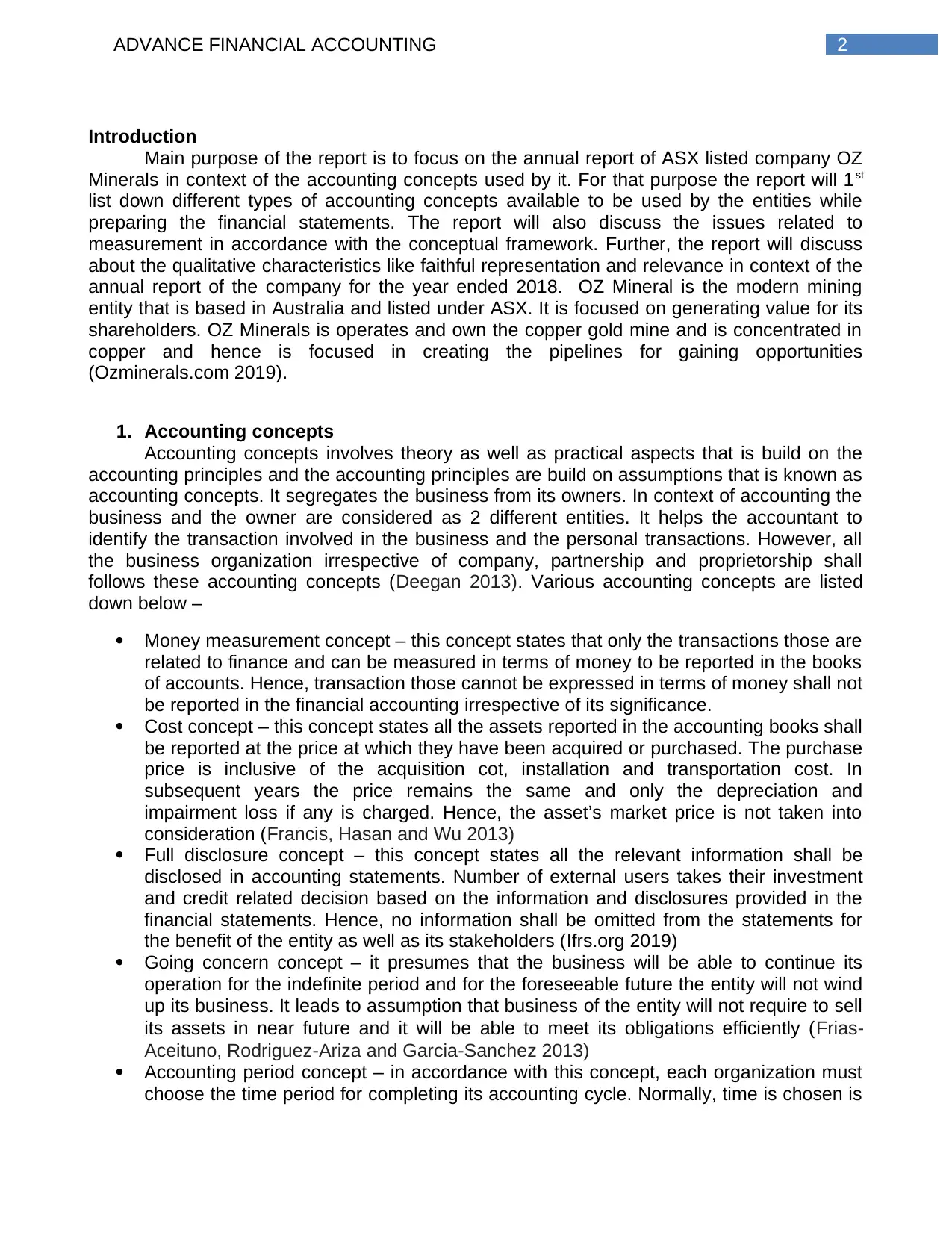
2ADVANCE FINANCIAL ACCOUNTING
Introduction
Main purpose of the report is to focus on the annual report of ASX listed company OZ
Minerals in context of the accounting concepts used by it. For that purpose the report will 1st
list down different types of accounting concepts available to be used by the entities while
preparing the financial statements. The report will also discuss the issues related to
measurement in accordance with the conceptual framework. Further, the report will discuss
about the qualitative characteristics like faithful representation and relevance in context of the
annual report of the company for the year ended 2018. OZ Mineral is the modern mining
entity that is based in Australia and listed under ASX. It is focused on generating value for its
shareholders. OZ Minerals is operates and own the copper gold mine and is concentrated in
copper and hence is focused in creating the pipelines for gaining opportunities
(Ozminerals.com 2019).
1. Accounting concepts
Accounting concepts involves theory as well as practical aspects that is build on the
accounting principles and the accounting principles are build on assumptions that is known as
accounting concepts. It segregates the business from its owners. In context of accounting the
business and the owner are considered as 2 different entities. It helps the accountant to
identify the transaction involved in the business and the personal transactions. However, all
the business organization irrespective of company, partnership and proprietorship shall
follows these accounting concepts (Deegan 2013). Various accounting concepts are listed
down below –
Money measurement concept – this concept states that only the transactions those are
related to finance and can be measured in terms of money to be reported in the books
of accounts. Hence, transaction those cannot be expressed in terms of money shall not
be reported in the financial accounting irrespective of its significance.
Cost concept – this concept states all the assets reported in the accounting books shall
be reported at the price at which they have been acquired or purchased. The purchase
price is inclusive of the acquisition cot, installation and transportation cost. In
subsequent years the price remains the same and only the depreciation and
impairment loss if any is charged. Hence, the asset’s market price is not taken into
consideration (Francis, Hasan and Wu 2013)
Full disclosure concept – this concept states all the relevant information shall be
disclosed in accounting statements. Number of external users takes their investment
and credit related decision based on the information and disclosures provided in the
financial statements. Hence, no information shall be omitted from the statements for
the benefit of the entity as well as its stakeholders (Ifrs.org 2019)
Going concern concept – it presumes that the business will be able to continue its
operation for the indefinite period and for the foreseeable future the entity will not wind
up its business. It leads to assumption that business of the entity will not require to sell
its assets in near future and it will be able to meet its obligations efficiently (Frias‐
Aceituno, Rodriguez‐Ariza and Garcia‐Sanchez 2013)
Accounting period concept – in accordance with this concept, each organization must
choose the time period for completing its accounting cycle. Normally, time is chosen is
Introduction
Main purpose of the report is to focus on the annual report of ASX listed company OZ
Minerals in context of the accounting concepts used by it. For that purpose the report will 1st
list down different types of accounting concepts available to be used by the entities while
preparing the financial statements. The report will also discuss the issues related to
measurement in accordance with the conceptual framework. Further, the report will discuss
about the qualitative characteristics like faithful representation and relevance in context of the
annual report of the company for the year ended 2018. OZ Mineral is the modern mining
entity that is based in Australia and listed under ASX. It is focused on generating value for its
shareholders. OZ Minerals is operates and own the copper gold mine and is concentrated in
copper and hence is focused in creating the pipelines for gaining opportunities
(Ozminerals.com 2019).
1. Accounting concepts
Accounting concepts involves theory as well as practical aspects that is build on the
accounting principles and the accounting principles are build on assumptions that is known as
accounting concepts. It segregates the business from its owners. In context of accounting the
business and the owner are considered as 2 different entities. It helps the accountant to
identify the transaction involved in the business and the personal transactions. However, all
the business organization irrespective of company, partnership and proprietorship shall
follows these accounting concepts (Deegan 2013). Various accounting concepts are listed
down below –
Money measurement concept – this concept states that only the transactions those are
related to finance and can be measured in terms of money to be reported in the books
of accounts. Hence, transaction those cannot be expressed in terms of money shall not
be reported in the financial accounting irrespective of its significance.
Cost concept – this concept states all the assets reported in the accounting books shall
be reported at the price at which they have been acquired or purchased. The purchase
price is inclusive of the acquisition cot, installation and transportation cost. In
subsequent years the price remains the same and only the depreciation and
impairment loss if any is charged. Hence, the asset’s market price is not taken into
consideration (Francis, Hasan and Wu 2013)
Full disclosure concept – this concept states all the relevant information shall be
disclosed in accounting statements. Number of external users takes their investment
and credit related decision based on the information and disclosures provided in the
financial statements. Hence, no information shall be omitted from the statements for
the benefit of the entity as well as its stakeholders (Ifrs.org 2019)
Going concern concept – it presumes that the business will be able to continue its
operation for the indefinite period and for the foreseeable future the entity will not wind
up its business. It leads to assumption that business of the entity will not require to sell
its assets in near future and it will be able to meet its obligations efficiently (Frias‐
Aceituno, Rodriguez‐Ariza and Garcia‐Sanchez 2013)
Accounting period concept – in accordance with this concept, each organization must
choose the time period for completing its accounting cycle. Normally, time is chosen is
You're viewing a preview
Unlock full access by subscribing today!
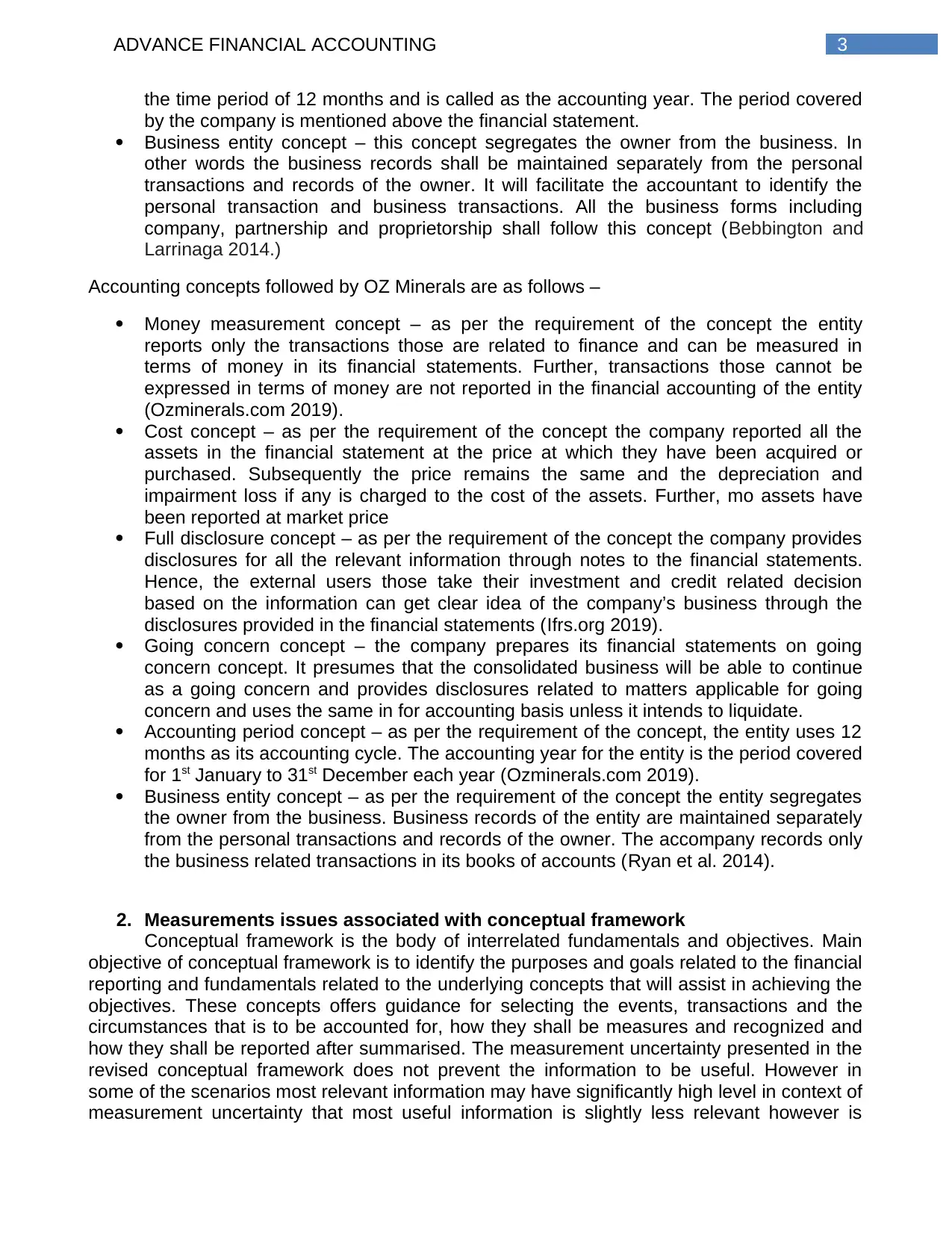
3ADVANCE FINANCIAL ACCOUNTING
the time period of 12 months and is called as the accounting year. The period covered
by the company is mentioned above the financial statement.
Business entity concept – this concept segregates the owner from the business. In
other words the business records shall be maintained separately from the personal
transactions and records of the owner. It will facilitate the accountant to identify the
personal transaction and business transactions. All the business forms including
company, partnership and proprietorship shall follow this concept (Bebbington and
Larrinaga 2014.)
Accounting concepts followed by OZ Minerals are as follows –
Money measurement concept – as per the requirement of the concept the entity
reports only the transactions those are related to finance and can be measured in
terms of money in its financial statements. Further, transactions those cannot be
expressed in terms of money are not reported in the financial accounting of the entity
(Ozminerals.com 2019).
Cost concept – as per the requirement of the concept the company reported all the
assets in the financial statement at the price at which they have been acquired or
purchased. Subsequently the price remains the same and the depreciation and
impairment loss if any is charged to the cost of the assets. Further, mo assets have
been reported at market price
Full disclosure concept – as per the requirement of the concept the company provides
disclosures for all the relevant information through notes to the financial statements.
Hence, the external users those take their investment and credit related decision
based on the information can get clear idea of the company’s business through the
disclosures provided in the financial statements (Ifrs.org 2019).
Going concern concept – the company prepares its financial statements on going
concern concept. It presumes that the consolidated business will be able to continue
as a going concern and provides disclosures related to matters applicable for going
concern and uses the same in for accounting basis unless it intends to liquidate.
Accounting period concept – as per the requirement of the concept, the entity uses 12
months as its accounting cycle. The accounting year for the entity is the period covered
for 1st January to 31st December each year (Ozminerals.com 2019).
Business entity concept – as per the requirement of the concept the entity segregates
the owner from the business. Business records of the entity are maintained separately
from the personal transactions and records of the owner. The accompany records only
the business related transactions in its books of accounts (Ryan et al. 2014).
2. Measurements issues associated with conceptual framework
Conceptual framework is the body of interrelated fundamentals and objectives. Main
objective of conceptual framework is to identify the purposes and goals related to the financial
reporting and fundamentals related to the underlying concepts that will assist in achieving the
objectives. These concepts offers guidance for selecting the events, transactions and the
circumstances that is to be accounted for, how they shall be measures and recognized and
how they shall be reported after summarised. The measurement uncertainty presented in the
revised conceptual framework does not prevent the information to be useful. However in
some of the scenarios most relevant information may have significantly high level in context of
measurement uncertainty that most useful information is slightly less relevant however is
the time period of 12 months and is called as the accounting year. The period covered
by the company is mentioned above the financial statement.
Business entity concept – this concept segregates the owner from the business. In
other words the business records shall be maintained separately from the personal
transactions and records of the owner. It will facilitate the accountant to identify the
personal transaction and business transactions. All the business forms including
company, partnership and proprietorship shall follow this concept (Bebbington and
Larrinaga 2014.)
Accounting concepts followed by OZ Minerals are as follows –
Money measurement concept – as per the requirement of the concept the entity
reports only the transactions those are related to finance and can be measured in
terms of money in its financial statements. Further, transactions those cannot be
expressed in terms of money are not reported in the financial accounting of the entity
(Ozminerals.com 2019).
Cost concept – as per the requirement of the concept the company reported all the
assets in the financial statement at the price at which they have been acquired or
purchased. Subsequently the price remains the same and the depreciation and
impairment loss if any is charged to the cost of the assets. Further, mo assets have
been reported at market price
Full disclosure concept – as per the requirement of the concept the company provides
disclosures for all the relevant information through notes to the financial statements.
Hence, the external users those take their investment and credit related decision
based on the information can get clear idea of the company’s business through the
disclosures provided in the financial statements (Ifrs.org 2019).
Going concern concept – the company prepares its financial statements on going
concern concept. It presumes that the consolidated business will be able to continue
as a going concern and provides disclosures related to matters applicable for going
concern and uses the same in for accounting basis unless it intends to liquidate.
Accounting period concept – as per the requirement of the concept, the entity uses 12
months as its accounting cycle. The accounting year for the entity is the period covered
for 1st January to 31st December each year (Ozminerals.com 2019).
Business entity concept – as per the requirement of the concept the entity segregates
the owner from the business. Business records of the entity are maintained separately
from the personal transactions and records of the owner. The accompany records only
the business related transactions in its books of accounts (Ryan et al. 2014).
2. Measurements issues associated with conceptual framework
Conceptual framework is the body of interrelated fundamentals and objectives. Main
objective of conceptual framework is to identify the purposes and goals related to the financial
reporting and fundamentals related to the underlying concepts that will assist in achieving the
objectives. These concepts offers guidance for selecting the events, transactions and the
circumstances that is to be accounted for, how they shall be measures and recognized and
how they shall be reported after summarised. The measurement uncertainty presented in the
revised conceptual framework does not prevent the information to be useful. However in
some of the scenarios most relevant information may have significantly high level in context of
measurement uncertainty that most useful information is slightly less relevant however is
Paraphrase This Document
Need a fresh take? Get an instant paraphrase of this document with our AI Paraphraser
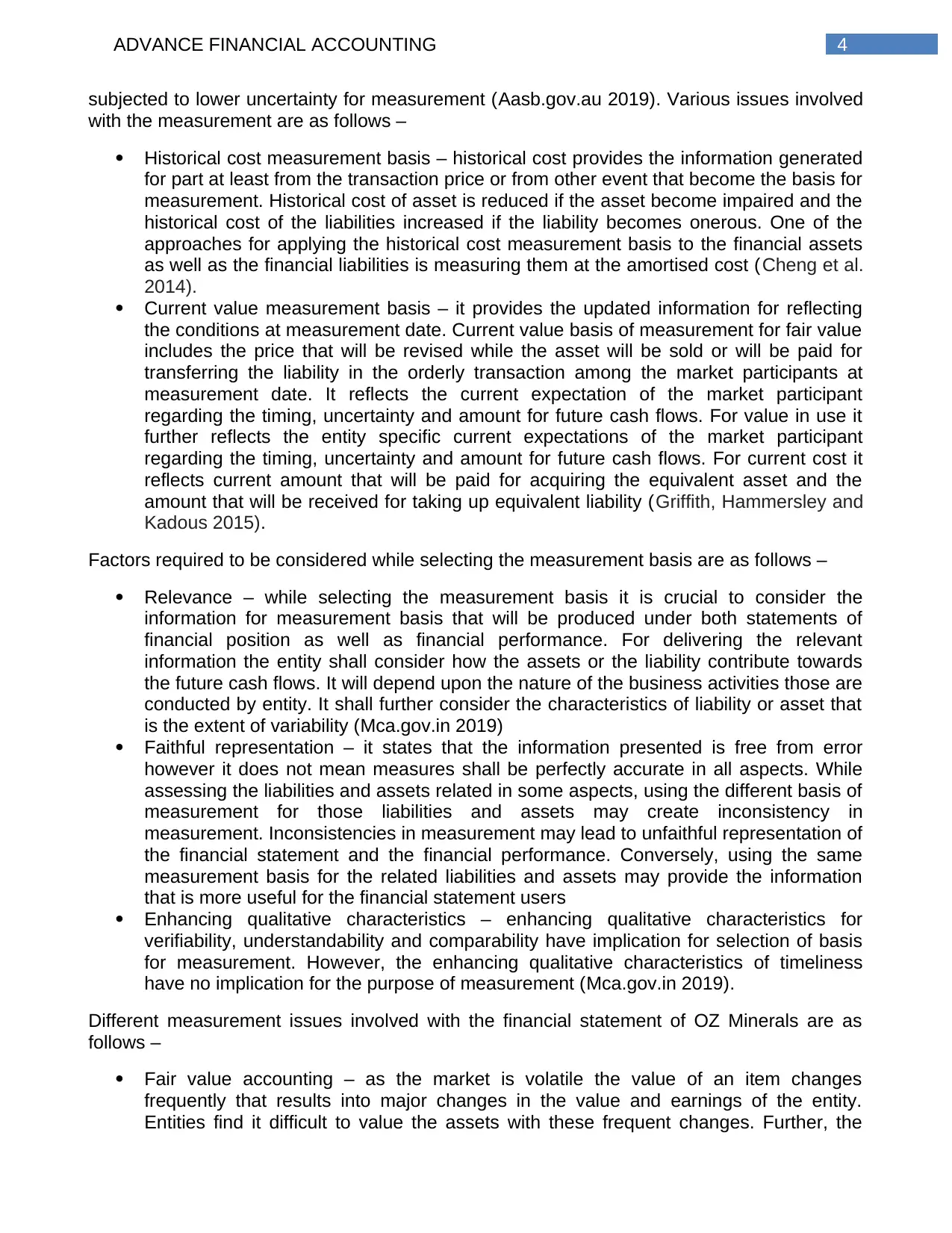
4ADVANCE FINANCIAL ACCOUNTING
subjected to lower uncertainty for measurement (Aasb.gov.au 2019). Various issues involved
with the measurement are as follows –
Historical cost measurement basis – historical cost provides the information generated
for part at least from the transaction price or from other event that become the basis for
measurement. Historical cost of asset is reduced if the asset become impaired and the
historical cost of the liabilities increased if the liability becomes onerous. One of the
approaches for applying the historical cost measurement basis to the financial assets
as well as the financial liabilities is measuring them at the amortised cost (Cheng et al.
2014).
Current value measurement basis – it provides the updated information for reflecting
the conditions at measurement date. Current value basis of measurement for fair value
includes the price that will be revised while the asset will be sold or will be paid for
transferring the liability in the orderly transaction among the market participants at
measurement date. It reflects the current expectation of the market participant
regarding the timing, uncertainty and amount for future cash flows. For value in use it
further reflects the entity specific current expectations of the market participant
regarding the timing, uncertainty and amount for future cash flows. For current cost it
reflects current amount that will be paid for acquiring the equivalent asset and the
amount that will be received for taking up equivalent liability (Griffith, Hammersley and
Kadous 2015).
Factors required to be considered while selecting the measurement basis are as follows –
Relevance – while selecting the measurement basis it is crucial to consider the
information for measurement basis that will be produced under both statements of
financial position as well as financial performance. For delivering the relevant
information the entity shall consider how the assets or the liability contribute towards
the future cash flows. It will depend upon the nature of the business activities those are
conducted by entity. It shall further consider the characteristics of liability or asset that
is the extent of variability (Mca.gov.in 2019)
Faithful representation – it states that the information presented is free from error
however it does not mean measures shall be perfectly accurate in all aspects. While
assessing the liabilities and assets related in some aspects, using the different basis of
measurement for those liabilities and assets may create inconsistency in
measurement. Inconsistencies in measurement may lead to unfaithful representation of
the financial statement and the financial performance. Conversely, using the same
measurement basis for the related liabilities and assets may provide the information
that is more useful for the financial statement users
Enhancing qualitative characteristics – enhancing qualitative characteristics for
verifiability, understandability and comparability have implication for selection of basis
for measurement. However, the enhancing qualitative characteristics of timeliness
have no implication for the purpose of measurement (Mca.gov.in 2019).
Different measurement issues involved with the financial statement of OZ Minerals are as
follows –
Fair value accounting – as the market is volatile the value of an item changes
frequently that results into major changes in the value and earnings of the entity.
Entities find it difficult to value the assets with these frequent changes. Further, the
subjected to lower uncertainty for measurement (Aasb.gov.au 2019). Various issues involved
with the measurement are as follows –
Historical cost measurement basis – historical cost provides the information generated
for part at least from the transaction price or from other event that become the basis for
measurement. Historical cost of asset is reduced if the asset become impaired and the
historical cost of the liabilities increased if the liability becomes onerous. One of the
approaches for applying the historical cost measurement basis to the financial assets
as well as the financial liabilities is measuring them at the amortised cost (Cheng et al.
2014).
Current value measurement basis – it provides the updated information for reflecting
the conditions at measurement date. Current value basis of measurement for fair value
includes the price that will be revised while the asset will be sold or will be paid for
transferring the liability in the orderly transaction among the market participants at
measurement date. It reflects the current expectation of the market participant
regarding the timing, uncertainty and amount for future cash flows. For value in use it
further reflects the entity specific current expectations of the market participant
regarding the timing, uncertainty and amount for future cash flows. For current cost it
reflects current amount that will be paid for acquiring the equivalent asset and the
amount that will be received for taking up equivalent liability (Griffith, Hammersley and
Kadous 2015).
Factors required to be considered while selecting the measurement basis are as follows –
Relevance – while selecting the measurement basis it is crucial to consider the
information for measurement basis that will be produced under both statements of
financial position as well as financial performance. For delivering the relevant
information the entity shall consider how the assets or the liability contribute towards
the future cash flows. It will depend upon the nature of the business activities those are
conducted by entity. It shall further consider the characteristics of liability or asset that
is the extent of variability (Mca.gov.in 2019)
Faithful representation – it states that the information presented is free from error
however it does not mean measures shall be perfectly accurate in all aspects. While
assessing the liabilities and assets related in some aspects, using the different basis of
measurement for those liabilities and assets may create inconsistency in
measurement. Inconsistencies in measurement may lead to unfaithful representation of
the financial statement and the financial performance. Conversely, using the same
measurement basis for the related liabilities and assets may provide the information
that is more useful for the financial statement users
Enhancing qualitative characteristics – enhancing qualitative characteristics for
verifiability, understandability and comparability have implication for selection of basis
for measurement. However, the enhancing qualitative characteristics of timeliness
have no implication for the purpose of measurement (Mca.gov.in 2019).
Different measurement issues involved with the financial statement of OZ Minerals are as
follows –
Fair value accounting – as the market is volatile the value of an item changes
frequently that results into major changes in the value and earnings of the entity.
Entities find it difficult to value the assets with these frequent changes. Further, the
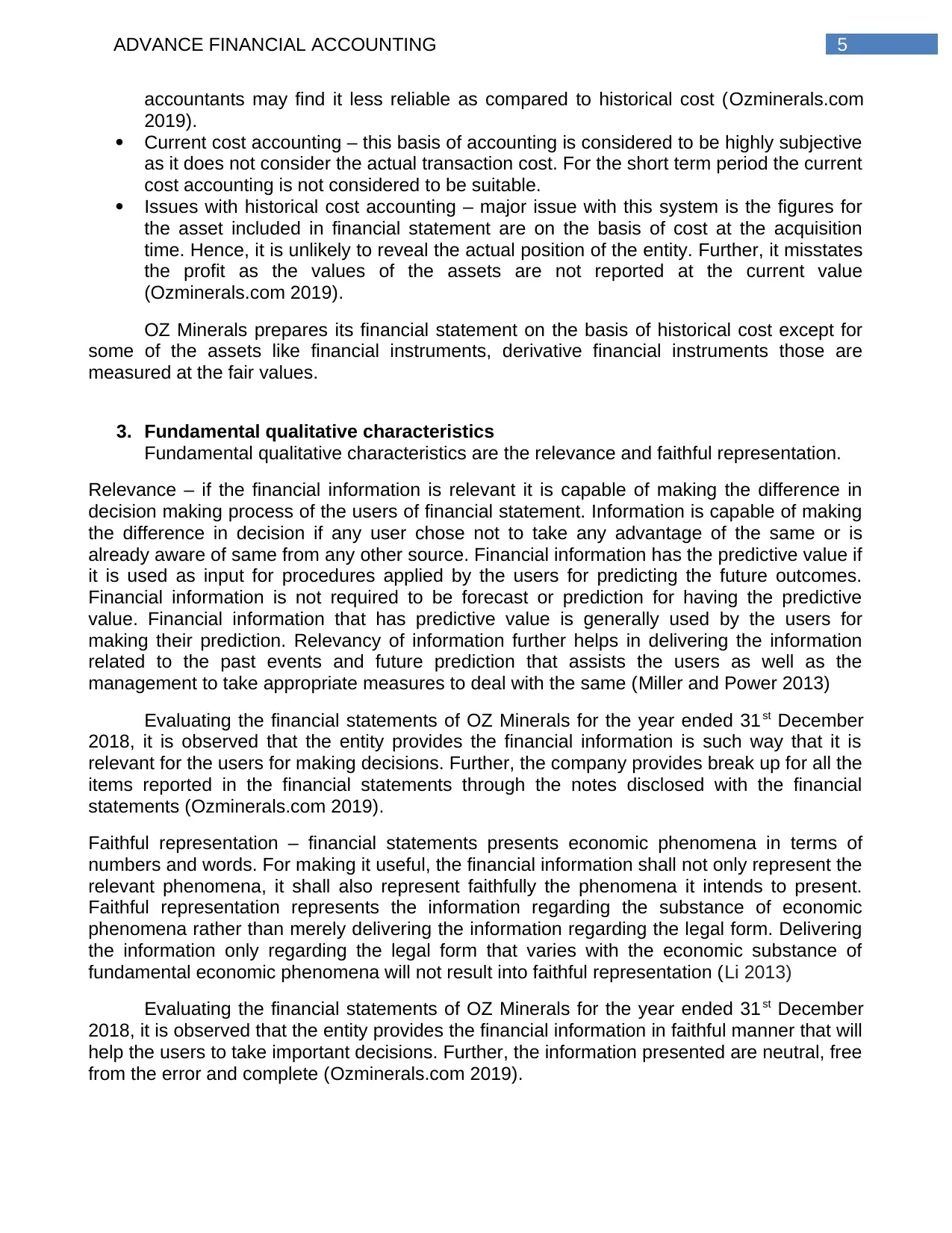
5ADVANCE FINANCIAL ACCOUNTING
accountants may find it less reliable as compared to historical cost (Ozminerals.com
2019).
Current cost accounting – this basis of accounting is considered to be highly subjective
as it does not consider the actual transaction cost. For the short term period the current
cost accounting is not considered to be suitable.
Issues with historical cost accounting – major issue with this system is the figures for
the asset included in financial statement are on the basis of cost at the acquisition
time. Hence, it is unlikely to reveal the actual position of the entity. Further, it misstates
the profit as the values of the assets are not reported at the current value
(Ozminerals.com 2019).
OZ Minerals prepares its financial statement on the basis of historical cost except for
some of the assets like financial instruments, derivative financial instruments those are
measured at the fair values.
3. Fundamental qualitative characteristics
Fundamental qualitative characteristics are the relevance and faithful representation.
Relevance – if the financial information is relevant it is capable of making the difference in
decision making process of the users of financial statement. Information is capable of making
the difference in decision if any user chose not to take any advantage of the same or is
already aware of same from any other source. Financial information has the predictive value if
it is used as input for procedures applied by the users for predicting the future outcomes.
Financial information is not required to be forecast or prediction for having the predictive
value. Financial information that has predictive value is generally used by the users for
making their prediction. Relevancy of information further helps in delivering the information
related to the past events and future prediction that assists the users as well as the
management to take appropriate measures to deal with the same (Miller and Power 2013)
Evaluating the financial statements of OZ Minerals for the year ended 31st December
2018, it is observed that the entity provides the financial information is such way that it is
relevant for the users for making decisions. Further, the company provides break up for all the
items reported in the financial statements through the notes disclosed with the financial
statements (Ozminerals.com 2019).
Faithful representation – financial statements presents economic phenomena in terms of
numbers and words. For making it useful, the financial information shall not only represent the
relevant phenomena, it shall also represent faithfully the phenomena it intends to present.
Faithful representation represents the information regarding the substance of economic
phenomena rather than merely delivering the information regarding the legal form. Delivering
the information only regarding the legal form that varies with the economic substance of
fundamental economic phenomena will not result into faithful representation (Li 2013)
Evaluating the financial statements of OZ Minerals for the year ended 31st December
2018, it is observed that the entity provides the financial information in faithful manner that will
help the users to take important decisions. Further, the information presented are neutral, free
from the error and complete (Ozminerals.com 2019).
accountants may find it less reliable as compared to historical cost (Ozminerals.com
2019).
Current cost accounting – this basis of accounting is considered to be highly subjective
as it does not consider the actual transaction cost. For the short term period the current
cost accounting is not considered to be suitable.
Issues with historical cost accounting – major issue with this system is the figures for
the asset included in financial statement are on the basis of cost at the acquisition
time. Hence, it is unlikely to reveal the actual position of the entity. Further, it misstates
the profit as the values of the assets are not reported at the current value
(Ozminerals.com 2019).
OZ Minerals prepares its financial statement on the basis of historical cost except for
some of the assets like financial instruments, derivative financial instruments those are
measured at the fair values.
3. Fundamental qualitative characteristics
Fundamental qualitative characteristics are the relevance and faithful representation.
Relevance – if the financial information is relevant it is capable of making the difference in
decision making process of the users of financial statement. Information is capable of making
the difference in decision if any user chose not to take any advantage of the same or is
already aware of same from any other source. Financial information has the predictive value if
it is used as input for procedures applied by the users for predicting the future outcomes.
Financial information is not required to be forecast or prediction for having the predictive
value. Financial information that has predictive value is generally used by the users for
making their prediction. Relevancy of information further helps in delivering the information
related to the past events and future prediction that assists the users as well as the
management to take appropriate measures to deal with the same (Miller and Power 2013)
Evaluating the financial statements of OZ Minerals for the year ended 31st December
2018, it is observed that the entity provides the financial information is such way that it is
relevant for the users for making decisions. Further, the company provides break up for all the
items reported in the financial statements through the notes disclosed with the financial
statements (Ozminerals.com 2019).
Faithful representation – financial statements presents economic phenomena in terms of
numbers and words. For making it useful, the financial information shall not only represent the
relevant phenomena, it shall also represent faithfully the phenomena it intends to present.
Faithful representation represents the information regarding the substance of economic
phenomena rather than merely delivering the information regarding the legal form. Delivering
the information only regarding the legal form that varies with the economic substance of
fundamental economic phenomena will not result into faithful representation (Li 2013)
Evaluating the financial statements of OZ Minerals for the year ended 31st December
2018, it is observed that the entity provides the financial information in faithful manner that will
help the users to take important decisions. Further, the information presented are neutral, free
from the error and complete (Ozminerals.com 2019).
You're viewing a preview
Unlock full access by subscribing today!
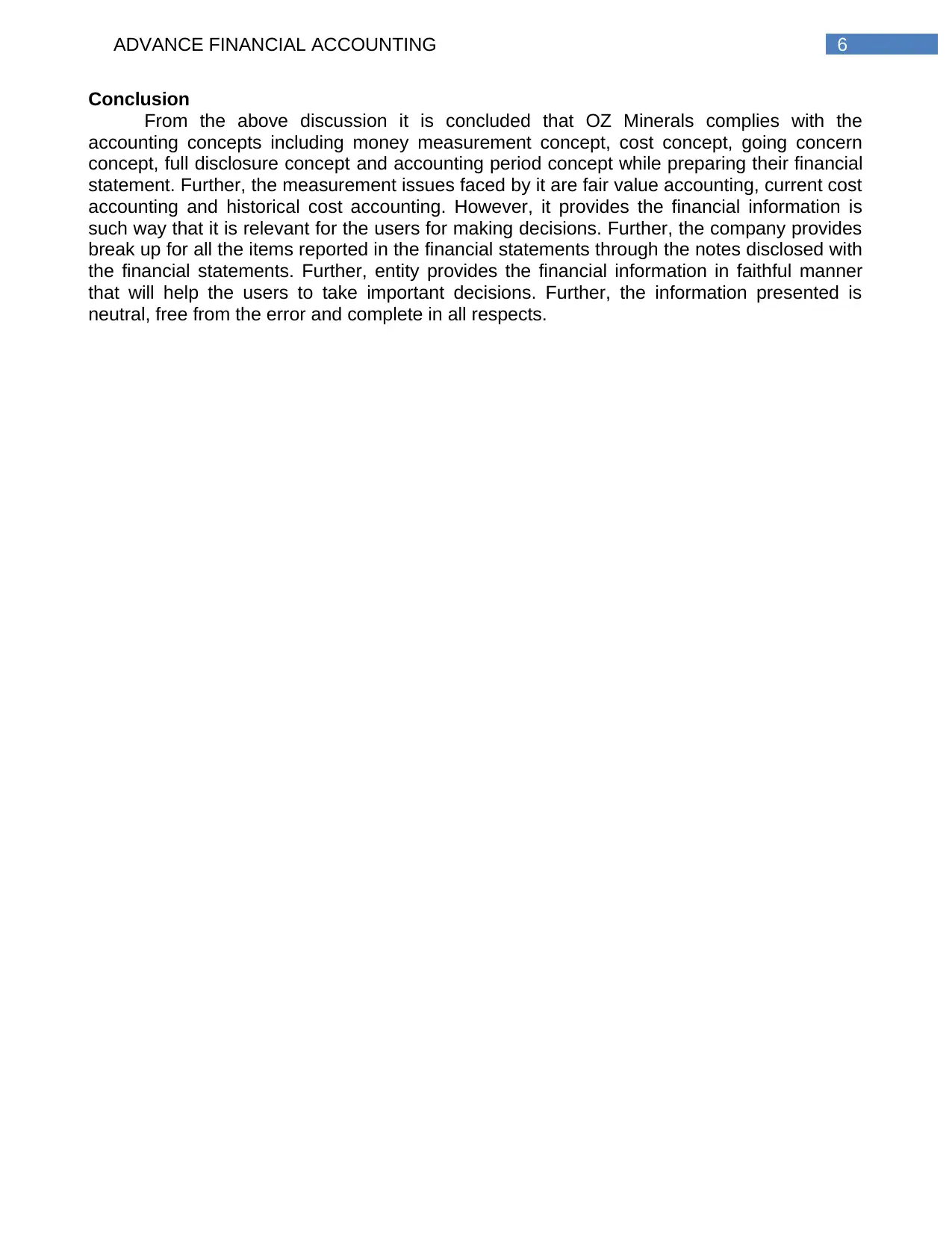
6ADVANCE FINANCIAL ACCOUNTING
Conclusion
From the above discussion it is concluded that OZ Minerals complies with the
accounting concepts including money measurement concept, cost concept, going concern
concept, full disclosure concept and accounting period concept while preparing their financial
statement. Further, the measurement issues faced by it are fair value accounting, current cost
accounting and historical cost accounting. However, it provides the financial information is
such way that it is relevant for the users for making decisions. Further, the company provides
break up for all the items reported in the financial statements through the notes disclosed with
the financial statements. Further, entity provides the financial information in faithful manner
that will help the users to take important decisions. Further, the information presented is
neutral, free from the error and complete in all respects.
Conclusion
From the above discussion it is concluded that OZ Minerals complies with the
accounting concepts including money measurement concept, cost concept, going concern
concept, full disclosure concept and accounting period concept while preparing their financial
statement. Further, the measurement issues faced by it are fair value accounting, current cost
accounting and historical cost accounting. However, it provides the financial information is
such way that it is relevant for the users for making decisions. Further, the company provides
break up for all the items reported in the financial statements through the notes disclosed with
the financial statements. Further, entity provides the financial information in faithful manner
that will help the users to take important decisions. Further, the information presented is
neutral, free from the error and complete in all respects.
Paraphrase This Document
Need a fresh take? Get an instant paraphrase of this document with our AI Paraphraser
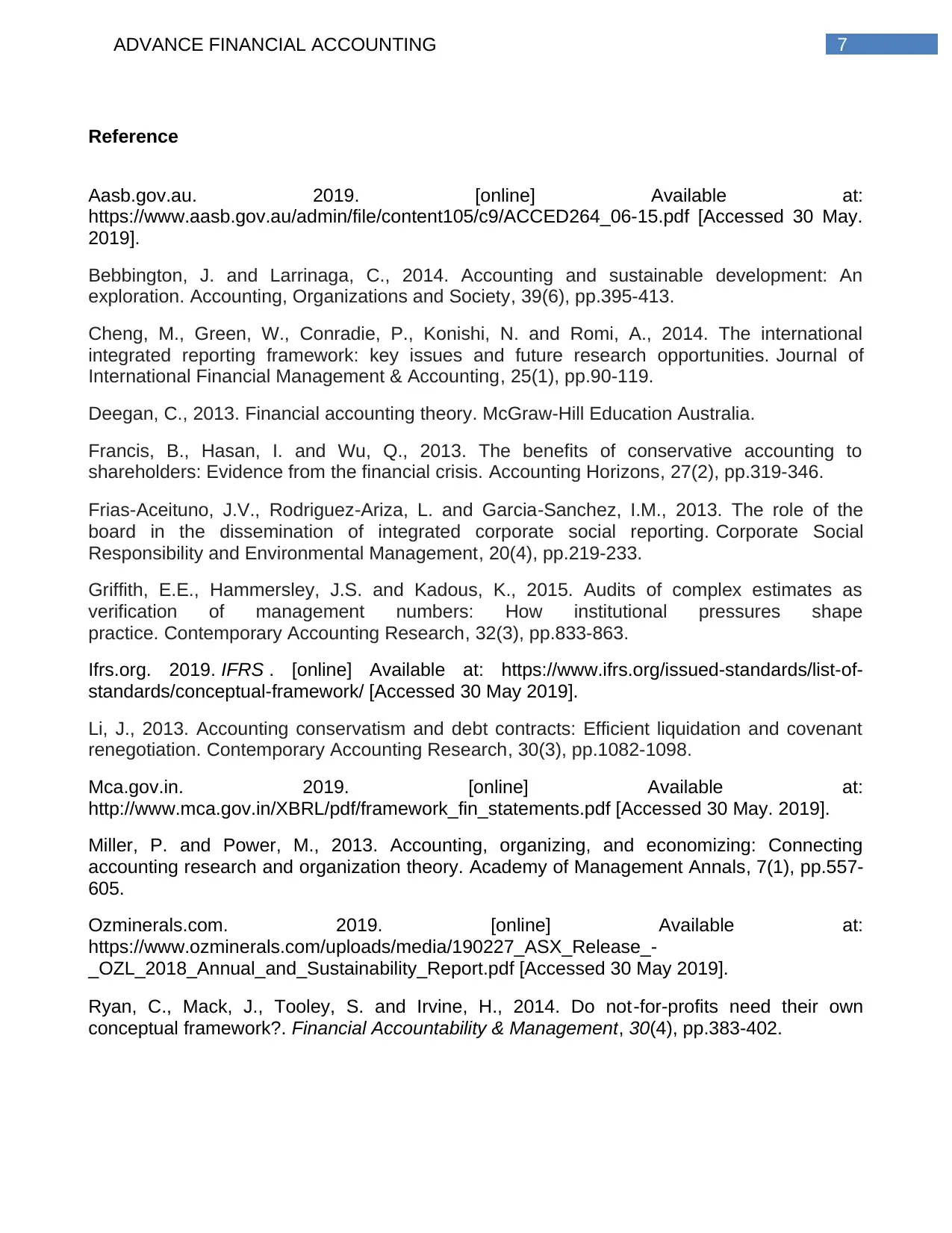
7ADVANCE FINANCIAL ACCOUNTING
Reference
Aasb.gov.au. 2019. [online] Available at:
https://www.aasb.gov.au/admin/file/content105/c9/ACCED264_06-15.pdf [Accessed 30 May.
2019].
Bebbington, J. and Larrinaga, C., 2014. Accounting and sustainable development: An
exploration. Accounting, Organizations and Society, 39(6), pp.395-413.
Cheng, M., Green, W., Conradie, P., Konishi, N. and Romi, A., 2014. The international
integrated reporting framework: key issues and future research opportunities. Journal of
International Financial Management & Accounting, 25(1), pp.90-119.
Deegan, C., 2013. Financial accounting theory. McGraw-Hill Education Australia.
Francis, B., Hasan, I. and Wu, Q., 2013. The benefits of conservative accounting to
shareholders: Evidence from the financial crisis. Accounting Horizons, 27(2), pp.319-346.
Frias‐Aceituno, J.V., Rodriguez‐Ariza, L. and Garcia‐Sanchez, I.M., 2013. The role of the
board in the dissemination of integrated corporate social reporting. Corporate Social
Responsibility and Environmental Management, 20(4), pp.219-233.
Griffith, E.E., Hammersley, J.S. and Kadous, K., 2015. Audits of complex estimates as
verification of management numbers: How institutional pressures shape
practice. Contemporary Accounting Research, 32(3), pp.833-863.
Ifrs.org. 2019. IFRS . [online] Available at: https://www.ifrs.org/issued-standards/list-of-
standards/conceptual-framework/ [Accessed 30 May 2019].
Li, J., 2013. Accounting conservatism and debt contracts: Efficient liquidation and covenant
renegotiation. Contemporary Accounting Research, 30(3), pp.1082-1098.
Mca.gov.in. 2019. [online] Available at:
http://www.mca.gov.in/XBRL/pdf/framework_fin_statements.pdf [Accessed 30 May. 2019].
Miller, P. and Power, M., 2013. Accounting, organizing, and economizing: Connecting
accounting research and organization theory. Academy of Management Annals, 7(1), pp.557-
605.
Ozminerals.com. 2019. [online] Available at:
https://www.ozminerals.com/uploads/media/190227_ASX_Release_-
_OZL_2018_Annual_and_Sustainability_Report.pdf [Accessed 30 May 2019].
Ryan, C., Mack, J., Tooley, S. and Irvine, H., 2014. Do not‐for‐profits need their own
conceptual framework?. Financial Accountability & Management, 30(4), pp.383-402.
Reference
Aasb.gov.au. 2019. [online] Available at:
https://www.aasb.gov.au/admin/file/content105/c9/ACCED264_06-15.pdf [Accessed 30 May.
2019].
Bebbington, J. and Larrinaga, C., 2014. Accounting and sustainable development: An
exploration. Accounting, Organizations and Society, 39(6), pp.395-413.
Cheng, M., Green, W., Conradie, P., Konishi, N. and Romi, A., 2014. The international
integrated reporting framework: key issues and future research opportunities. Journal of
International Financial Management & Accounting, 25(1), pp.90-119.
Deegan, C., 2013. Financial accounting theory. McGraw-Hill Education Australia.
Francis, B., Hasan, I. and Wu, Q., 2013. The benefits of conservative accounting to
shareholders: Evidence from the financial crisis. Accounting Horizons, 27(2), pp.319-346.
Frias‐Aceituno, J.V., Rodriguez‐Ariza, L. and Garcia‐Sanchez, I.M., 2013. The role of the
board in the dissemination of integrated corporate social reporting. Corporate Social
Responsibility and Environmental Management, 20(4), pp.219-233.
Griffith, E.E., Hammersley, J.S. and Kadous, K., 2015. Audits of complex estimates as
verification of management numbers: How institutional pressures shape
practice. Contemporary Accounting Research, 32(3), pp.833-863.
Ifrs.org. 2019. IFRS . [online] Available at: https://www.ifrs.org/issued-standards/list-of-
standards/conceptual-framework/ [Accessed 30 May 2019].
Li, J., 2013. Accounting conservatism and debt contracts: Efficient liquidation and covenant
renegotiation. Contemporary Accounting Research, 30(3), pp.1082-1098.
Mca.gov.in. 2019. [online] Available at:
http://www.mca.gov.in/XBRL/pdf/framework_fin_statements.pdf [Accessed 30 May. 2019].
Miller, P. and Power, M., 2013. Accounting, organizing, and economizing: Connecting
accounting research and organization theory. Academy of Management Annals, 7(1), pp.557-
605.
Ozminerals.com. 2019. [online] Available at:
https://www.ozminerals.com/uploads/media/190227_ASX_Release_-
_OZL_2018_Annual_and_Sustainability_Report.pdf [Accessed 30 May 2019].
Ryan, C., Mack, J., Tooley, S. and Irvine, H., 2014. Do not‐for‐profits need their own
conceptual framework?. Financial Accountability & Management, 30(4), pp.383-402.

8ADVANCE FINANCIAL ACCOUNTING
You're viewing a preview
Unlock full access by subscribing today!
1 out of 9
Related Documents
Your All-in-One AI-Powered Toolkit for Academic Success.
+13062052269
info@desklib.com
Available 24*7 on WhatsApp / Email
![[object Object]](/_next/static/media/star-bottom.7253800d.svg)
Unlock your academic potential
© 2024 | Zucol Services PVT LTD | All rights reserved.





